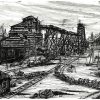Corridor Company Towns
Written by Wendi Blewett, DLNHC Museum Collections Manager
As someone who loves a good mystery (and research), I’ve often wondered how certain towns got started – were they created because they split off from an existing town? Were they built by settlers from another area because of the location or proximity to resources?

While researching town origins, we found that many towns in the Delaware & Lehigh National Heritage Corridor had been built for a specific purpose: they were company towns. In remote, underdeveloped, or undeveloped areas, companies would establish or enhance towns for their workers. Company towns flourished in 19th century America, where the discovery of resources generated an influx of industry and commerce.
Often these towns were planned to include not just homes, but stores, places of worship, and other amenities. Others, like Summit Hill, developed with far less planning. Summit Hill was little more than a mining camp opened by Lehigh Coal & Navigation Company after anthracite coal was discovered in the region. The Anthracite Coal Region was home to many company- or patch-towns, with Summit Hill generally regarded as the first. Patch-towns were very common; the name refers to the patches of company-owned land near a breaker or mine entrance where a handful of homes were built. These patches would grow along with the company. In some cases, several patch-towns were consolidated into one, like Lansford.
 Many patch-towns still exist today, like Glen Lyon and Lattimer – a complete list of towns would be too long to include, but this site has a fascinating compilation of towns and patches to browse. The site also includes company towns and patch-towns that no longer exist – Concrete City, for example, was a ‘model’ company town built for employees of DL&W Railroad’s coal company but was abandoned after 11 years. It lies in ruins outside of Nanticoke. The town of Eckley was also abandoned, but it lives on as Eckley Miners’ Village, a wonderful example of a company town frozen in time.
Many patch-towns still exist today, like Glen Lyon and Lattimer – a complete list of towns would be too long to include, but this site has a fascinating compilation of towns and patches to browse. The site also includes company towns and patch-towns that no longer exist – Concrete City, for example, was a ‘model’ company town built for employees of DL&W Railroad’s coal company but was abandoned after 11 years. It lies in ruins outside of Nanticoke. The town of Eckley was also abandoned, but it lives on as Eckley Miners’ Village, a wonderful example of a company town frozen in time.

Concrete City.
Like Eckley, which was previously known as Shingleton, many company towns were built on top of existing towns or settlements. Palmerton, for example, was incorporated in 1912 by the New Jersey Zinc Company on the same land as the villages of Hazard and Little Gap. Another example is Jim Thorpe! Though Lehigh Coal & Navigation founded the town as Mauch Chunk in 1818, the area served as an outpost for the Lehigh Coal Mine Company starting in the 1790s.
Company towns weren’t only located in the Anthracite Region – they were everywhere! Catasauqua, Hokendauqua, Alburtis, Fullerton, Glendon…the Lehigh Valley is full of them! Catasauqua was in its infancy when it was developed by David Thomas, a Welsh immigrant who built the Lehigh Crane Iron Works. Thomas, remembered as the “Father of Catasauqua,” was responsible for Catasauqua’s first church, first fire company, public water system, and the building of Crane company houses on Wood and Church Streets. His son Samuel oversaw the construction of two furnaces for the Thomas Iron Company on land that would later become Hokendauqua. Samuel also chartered the Lock Ridge Iron Company in the 1860s, constructing furnaces in Alburtis starting in 1867. The Thomas family generously contributed to the continued development of Catasauqua, Hokendauqua, and Alburtis. Just north of Allentown, the suburb of Fullerton was once a thriving company town. James W. Fuller, an industrialist who manufactured railroad axles and wheels, established the town in 1870. By 1883 it was thriving and grew even more with the cement industry boom of the 1900s. Glendon was also a company town, named after the Glendon Iron Works. Built by William Firmstone, the Iron Works was located on the land that is now Hugh Moore Park, and our National Canal Museum! The historic neighborhood of Harriman in Bristol used to be its own township, built by W. Averell Harriman to house workers of his shipyard.
 Other types of company towns were also prevalent in the Corridor. Morrisville, Hulmeville, and many more towns were the sites of sawmills and gristmills. Although mill and factory towns might not be considered company towns by some, they were built and developed around a company or industry. There was a symbiosis there; The mills provided work for citizens, and the citizens provided materials for the mills to process. Once sawmills had cleared the land, people planted crops. The crops needed to be processed, so gristmills were built. Other mills quarried stone or manufactured paper, textiles, or other goods to be sold to citizens and transported to other towns.
Other types of company towns were also prevalent in the Corridor. Morrisville, Hulmeville, and many more towns were the sites of sawmills and gristmills. Although mill and factory towns might not be considered company towns by some, they were built and developed around a company or industry. There was a symbiosis there; The mills provided work for citizens, and the citizens provided materials for the mills to process. Once sawmills had cleared the land, people planted crops. The crops needed to be processed, so gristmills were built. Other mills quarried stone or manufactured paper, textiles, or other goods to be sold to citizens and transported to other towns.
As transportation evolved, company towns diminished. Traveling longer distances was becoming easier and safer, and there was no need to work in the town you lived in, or vice versa. Stagecoach or bridle roads became auto roads or highways. Ferries became bridges, making river crossings much faster. Railroads and trolleys allowed many people to travel together. This evolution is actually the subject of our upcoming 2024 exhibition, where we hope you will join us to learn about the fascinating path of routes and paths throughout history!
Sources
“Anthracite-related Resources of Northeastern Pennsylvania, 1769 – 1945.” National Register of Historic Places, 1997. Pp 1 – 109.
Capwell Fox, Martha. “Geography, Geology, and Genius.”
“Coal Towns: Towns, Villages, Patches in the Coal Region.”























Join the Conversation!